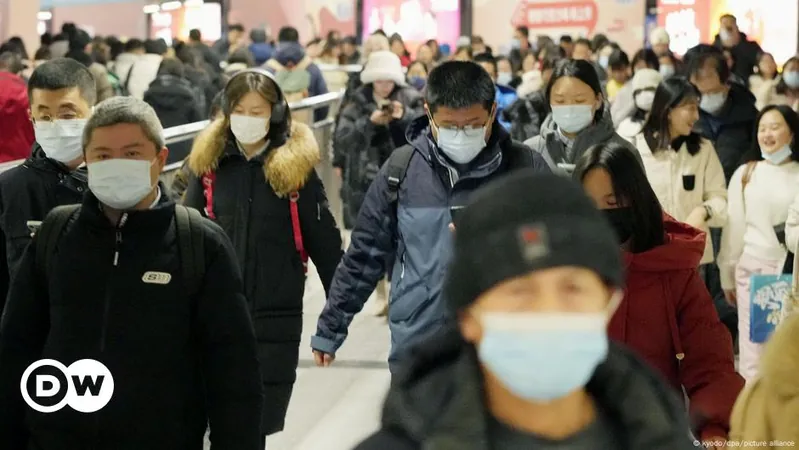
Surging HMPV Cases in China: What You Need to Know About This Respiratory Virus
2025-01-06
Author: Ming
Reports of a human metapneumovirus (HMPV) outbreak in various regions of China have caught the eye of the international community, raising concerns about respiratory infections during the cold season.
HMPV was first identified by Dutch researchers in 2001, although it has likely been circulating among humans for many generations prior. The recent reports of HMPV increase follow China's National Administration of Disease Control and Prevention announcement of a new reporting protocol related to pneumonia cases.
Current HMPV Outbreak Situation
The present outbreak in northern China marks a notable spike in HMPV cases, particularly affecting the younger population. Alongside, there's also been a rise in rhinovirus cases, a common cause of cold-like symptoms.
Interestingly, India’s Health Ministry has reported two cases of HMPV in Karnataka but reassured that HMPV is endemic globally and there hasn’t been any unusual increase in severe respiratory illness in the country.
Health experts remain calm, suggesting that the seasonal upsurge in HMPV cases is typical for this time of year. Jacqueline Stephens, an epidemiologist from Flinders University in Australia, noted that this pattern aligns with what is expected, particularly among children, since HMPV is often a culprit in respiratory illnesses in the pediatric population.
Jill Carr, another virologist from Flinders University, pointed out that the current situation with HMPV is fundamentally different from the onset of the coronavirus pandemic, during which there was no existing immunity.
Similarities to RSV
HMPV belongs to the same viral family as respiratory syncytial virus (RSV), which also causes respiratory infections that peak during colder months. Both viruses can lead to epidemic levels during particularly virulent seasons.
Before its identification in 2001, cases of HMPV were commonly misrepresented as RSV due to similar symptoms. Albert Osterhaus, who headed the original research team, stated that past findings showed that many children had antibodies against the HMPV virus, indicating long-standing exposure.
Unlike coronaviruses and influenza viruses, HMPV has demonstrated a relative stability, meaning it mutates less frequently and can re-infect people as immunity decreases over time. Osterhaus emphasized that while influenza is notorious for its mutations, HMPV remains consistent over the years.
Understanding HMPV Symptoms
HMPV can lead to infections in both the upper and lower respiratory tracts, with symptoms closely resembling those caused by RSV, such as coughing, fever, and nasal congestion. This symptom overlap may complicate diagnoses, particularly in milder cases. In more severe instances, complications like pneumonia or bronchitis may arise.
As with most respiratory viruses, HMPV is contagious. It spreads through airborne droplets when an infected person sneezes or coughs, along with contact with contaminated surfaces. Both very young children and the elderly are at heightened risk for severe illness.
Treatment and Vaccine Development
Currently, there is no specific treatment or vaccine for HMPV. Preventive strategies focus on good hygiene practices, such as frequent hand washing, avoiding contact with sick individuals, and wearing masks if necessary.
Excitingly, a vaccine for HMPV is in the pipeline, building on recent developments in RSV vaccines. Osterhaus believes we are on the brink of significant advancements, foreseeing that HMPV vaccines will likely be developed within the next few years leveraging the insights gained from RSV research.
Stay informed and take precautions, as our understanding of HMPV evolves and as we navigate through this respiratory virus's latest outbreak!

 Brasil (PT)
Brasil (PT)
 Canada (EN)
Canada (EN)
 Chile (ES)
Chile (ES)
 Česko (CS)
Česko (CS)
 대한민국 (KO)
대한민국 (KO)
 España (ES)
España (ES)
 France (FR)
France (FR)
 Hong Kong (EN)
Hong Kong (EN)
 Italia (IT)
Italia (IT)
 日本 (JA)
日本 (JA)
 Magyarország (HU)
Magyarország (HU)
 Norge (NO)
Norge (NO)
 Polska (PL)
Polska (PL)
 Schweiz (DE)
Schweiz (DE)
 Singapore (EN)
Singapore (EN)
 Sverige (SV)
Sverige (SV)
 Suomi (FI)
Suomi (FI)
 Türkiye (TR)
Türkiye (TR)
 الإمارات العربية المتحدة (AR)
الإمارات العربية المتحدة (AR)